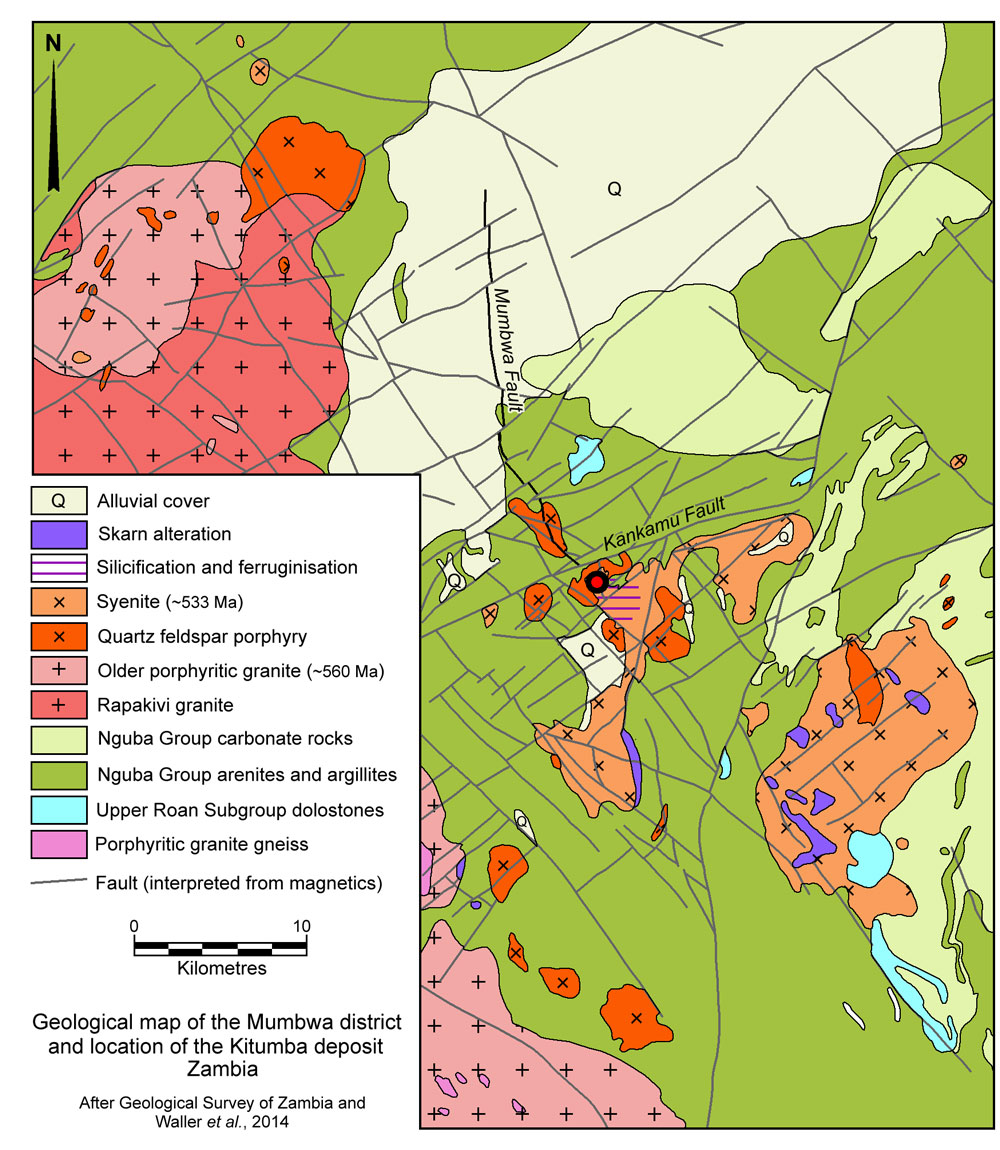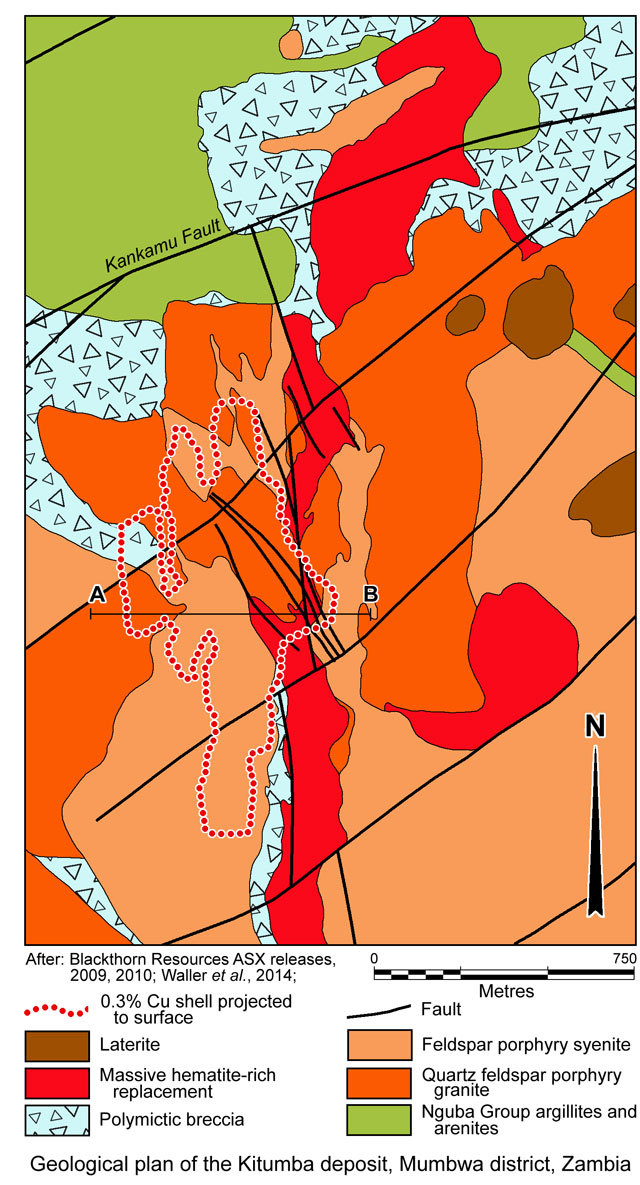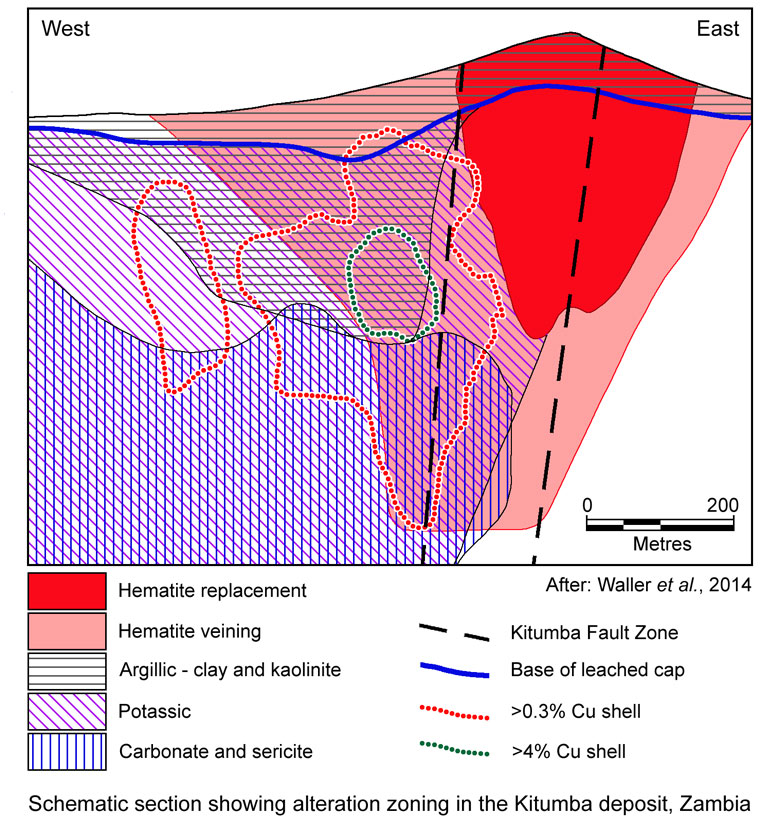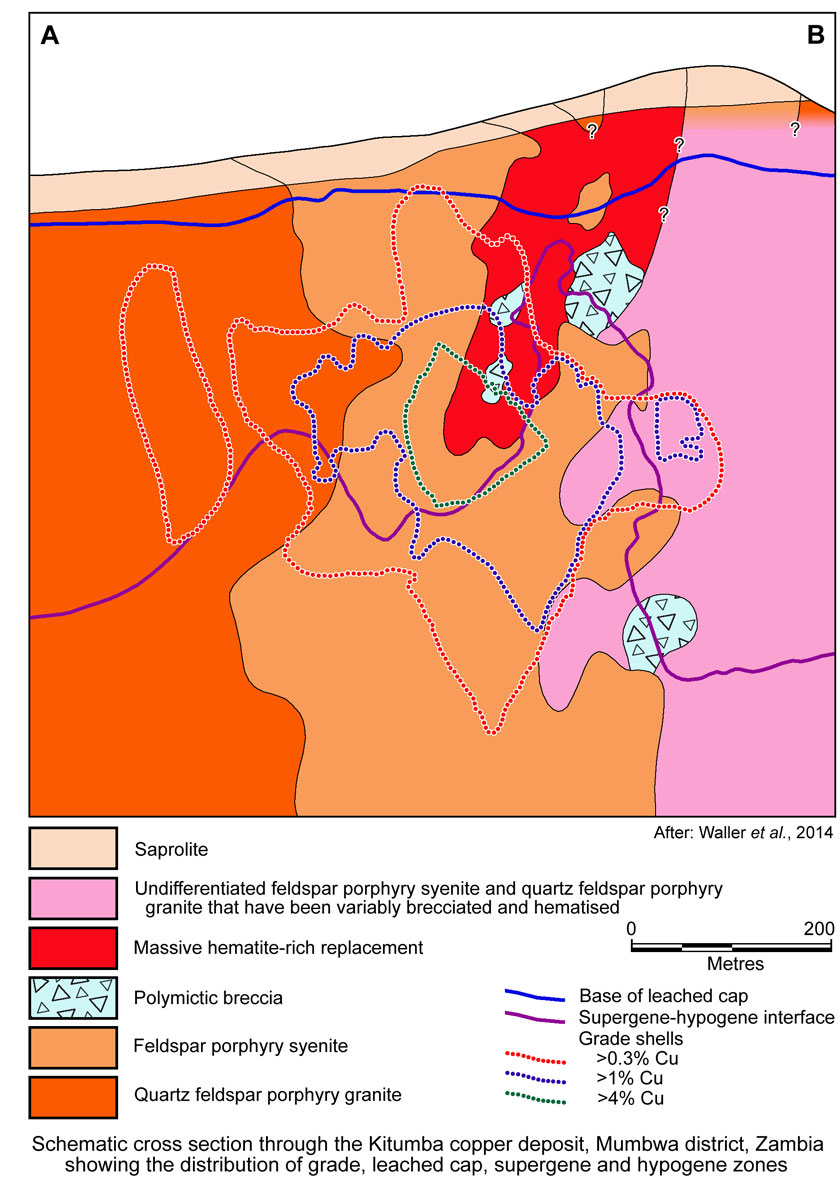|
Mumbwa District - Kitumba |
|
|
Zambia |
| Main commodities:
Cu Co
|
|
 |
|
 |
 |
Super Porphyry Cu and Au


|
IOCG Deposits - 70 papers

|
All papers now Open Access.
Available as Full Text for direct download or on request. |
|
 |
The Kitumba IOCG deposit in the Mumbwa district is located ~40 km NW of the town of Mumbwa and ~200 km west of Lusaka in Zambia (#Location: 14° 42' 23"S, 26° 48' 16"E).
Regional Setting
The Mumbwa district is located within the Katanga Core to the Lufilian Arc which hosts the Central African Copperbelt. For details of the Lufilian Arc and the regional occurrence of both sediment hosted copper and IOCG mineralisation (and iron oxide-alkali altered mineralised systems), see the separate Zambian Copperbelt record.
A number of iron oxide-alkali altered mineralised systems occur within the Katanga Core zone, around and within the syn- to post-tectonic 566 to 533 Ma Hook Granitoid Suite, which is bounded to the south by the ENE trending, transcontinental Mwembeshi Shear Zone. The Hook Granitoid Suite intrudes a sequence of carbonates and calc-arenites interlayered with shales and siltstones of the Katanga Supergroup Nguba Group. A 200 to 300 m thick succession of Permian to Jurassic Karoo Sequence siltstones and mudstones are developed within a northeast trending graben to the north, whilst large areas to the NW, within the Kafue River flood plain, are covered by Quaternary sediments consisting of alluvium and eluvium.
The Hook Granite batholith has proven to be complex, with numerous phases, both foliated and unfoliated, and extensive biotite-silica-K feldspar-tourmaline-epidote-magnetite-hematite-pyrite alteration. Aeromagnetic data differentiates the younger (~533 Ma) stage of the Hook Granitoid Suite that is apparently associated with iron oxide-alkali altered mineralisation (Nisbet et al., 2000). This younger phase includes late to post-tectonic A-type syenites/diorites, porphyritic granites, granites, diorites and gabbros.
The main exposed Hook Granite batholith in the Mumbwa area contains numerous iron and copper mineral occurrences while iron, gold and copper-silver mineralisation is found within the surrounding Katanga Supergroup sediments (Geological Survey of Zambia Mineral Maps; Nisbet, 2000). These occurrences are characterised by structurally-controlled, vertically oriented, hematite-rich, pipe-like breccia zones, from a few hundred metres, up to several kilometres in length (Hitzman, 2001; Nisbet, 2000).
Within the Katanga Core of the Lufilian Arc, intrusive and sedimentary rocks within iron oxide-alkali altered mineralised systems have undergone initial albitisation (e.g., at Kitumba; Lobo-Guerrero, 2010; 2005). This early albitisation is overprinted by potassic alteration, characterised by the formation of K feldspar. Magnetite is subsequently introduced into these altered rocks, to be in turn replaced by hematite during a late hydrolytic (sericite-chlorite) alteration event (Hitzman, 2001; Lobo-Guerrero, 2010). These breccias have a matrix of metallic hematite and/or magnetite, with evidence of explosive hydrothermal activity. Densely packed, polymictic, 'round-clast' breccias, cemented by iron oxides, are a common feature (Lobo-Guerrero, 2010). Lobo-Guerrero (2010) suggests textures indicate the clast rounding is the result of silica leaching and corrosion by extremely alkaline and/or acid (F-rich) hydrothermal solutions which have etched angular rock fragments, rather than by milling.
Iron oxide altered breccia may be overprinted by a final sulphidation event, resulting in the precipitation of pyrite and then chalcopyrite, frequently accompanied by fluorite, galena and sphalerite. Mineralisation is hosted by the Hook Granitoid Suite, and argillaceous and carbonate rocks of the Katanga Supergroup, sometimes with associated syenite. Gold mineralisation is usually found in silicified breccias hosted within a variety of rock types (Nisbet, 2000; Hitzman, 2001).
 Kitumba Deposit
Kitumba Deposit
Geology
The Kitumba IOCG sensu stricto mineralised system at Mumbwa is centred on a copper-gold anomalous hematite-sericite-quartz-apatite-barite-siderite alteration zone, with overlapping geophysical anomalies (magnetic, electrical, gravity and radiometric). It is located at the southern extremity of a NNW-SSE oriented, 26 km long corridor of continuous, but fluctuating geophysical anomalism near the eastern margin of the Hook Granite. This corridor is referred to as the Mumbwa Fault Zone. Apart from the Mumbwa Fault Zone, the district is also dominated by NW and NE trending conjugate fault sets which offset the Mumbwa Fault Zone in a number of places.
Two contiguous magmatic hydrothermal systems are developed within the Mumbwa Fault Zone corridor, centred on strong magnetic anomalies representing intense magnetite-amphibole-apatite alteration spatially associated with syenite porphyry intrusions. The southern Kitumba and northern Mutoya systems are separated by the Kankamu Fault. Both magmatic systems are zoned from deeper level magnetite-dominated alteration in the south, to higher level hematite-rich breccias in the north, and are subvertical and complex, arising from several phases of intrusion, commonly in the form of dyke swarms. The Mutoya system is much larger and extends for 19 km in a north-south direction along the Mumbwa Fault Zone, being defined by a prominent linear density anomaly and coincident magnetic anomaly in the south. The northern portion of Mutoya is masked by up to 200 m of Karoo sedimentary rocks (Waller et al., 2014).
 Kitumba is the main and only significant resource delineated to date. The Mutoya system has only returned narrow higher- (~0.9% Cu) or broad low-grade (~0.2% Cu) copper mineralisation in drill intersections (Blackthorn Resources releases; Lobo-Guerrero, 2010).
Kitumba is the main and only significant resource delineated to date. The Mutoya system has only returned narrow higher- (~0.9% Cu) or broad low-grade (~0.2% Cu) copper mineralisation in drill intersections (Blackthorn Resources releases; Lobo-Guerrero, 2010).
The mineralisation at Kitumba is associated with a large-scale and highly variable magmatic-hydrothermal iron oxide breccia complex, that is developed along the Kitumba Fault Zone, and exhibits signs of multiple brecciation. The complex is exposed as a prominent north-south oriented ridge of massive hematite replacement breccia that is ~1750 m long, by 100 to 400 m in width, forming part of the Kitumba Hills. The Kitumba Fault Zone is considered to represent a local structure within the broader Mumbwa Fault Zone. Three principal rock-type associations are recognised at Kitumba. Nguba Group metasedimentary rocks are intruded by quartz-feldspar porphyry granitoids which are in turn intruded by a feldspar porphyry diorite-syenite complex. Breccias are overprinted on these associations, occurring as distinct lithologies, and pervasive iron oxide replacement of various protoliths.
Nguba Group metasedimentary rocks comprise a sequence of thinly bedded calcareous siltstones and argillites with subordinate arenaceous partings that become more common to the north and west, away from the core of the Kitumba magmatic system, where they dip steeply to the south and east. Within the central parts of the Kitumba magmatic system, these metasedimentary rocks are mainly present as generally strongly altered breccia clasts at various scales. In the western part of the Kitumba system, they have a distinct laminated texture (Waller et al., 2014).
Quartz feldspar porphyry granite (or porphyry-textured granite) is characterised by rounded quartz phenocrysts, with lesser subequant feldspar phenocrysts, set within a grey to pink groundmass, the colour of which is determined by the dominant alteration present (Waller et al., 2014).
Feldspar porphyry diorite/syenite extensively intrudes both the metasedimentary rocks and porphyry granitoids. The protolith is considered to be a diorite, which has been extensively K feldspar altered, giving the rock a characteristic red colouration, to the appearance and composition of a syenite. It may also be altered by sericite which replaces what are thought to be plagioclase phenocrysts, giving the rock a distinctive olive grey colouration. Fine grained narrow micro-syenite dykes are also evident. A drill hole on the eastern side of the Kitumba Fault Zone intersected an unaltered grey porphyritic rock that may represent the protolith, a feldspar porphyry diorite (Waller et al., 2014).
The widespread brecciation that occurs throughout the Kitumba area, ranges from incipient crackle breccias through jigsaw, mosaic, rubble, clast supported, matrix-supported, disaggregated and polyphase breccias to corrosive transported (fluidised) matrix and clast-supported breccias. The breccia is developed within syenite and quartz feldspar porphyry of the Hook Granitoid Suite, and within the argillite and arenite of the Nguba Group. Numerous other hematite breccias are also found along the intrusive contact (Blackthorn Resources releases; Waller et al., 2014).
The main breccia zone has been dislocated into at least four segments with dextral offsets of ~100 m each, by northeast trending faults, with the breccia outline also influenced by the cross faults. The central part of the deposit is also crosscut by a subsequent intense zone of NNW to NW oriented faulting and fracturing. This complex structural regime developed a secondary permeability that apparently played a significant role in remobilisation and supergene concentration of copper and gold mineralisation (Waller et al., 2014).
Alteration
 The alteration system is zoned from north to south, with deeper level magnetite dominated the Sugar Loaf deposit, 3.8 km SW of Kitumba, to higher level hematite dominated alteration over Kitumba itself, corresponding to highs and lows in magnetic data respectively. The dominant alteration facies are as follows (after Waller et al., 2014):
The alteration system is zoned from north to south, with deeper level magnetite dominated the Sugar Loaf deposit, 3.8 km SW of Kitumba, to higher level hematite dominated alteration over Kitumba itself, corresponding to highs and lows in magnetic data respectively. The dominant alteration facies are as follows (after Waller et al., 2014):
• Magnetite-amphibole-apatite-carbonate alteration which is dominant to the south of Kitumba and in the southern Mutoya area north of the Kankamu Fault, and is reflected by magnetic highs. Its exposure is the result of uplift and tilting along northeast trending faults.
• K-feldspar alteration which is widespread, and occurs as selective replacement of feldspar phenocrysts in the porphyritic granite and the diorite-syenite, clasts within earlier breccias, and pervasive replacement of all three main rock types. It is most intensely developed in syenite and porphyritic syenite and is often associated with copper mineralisation, particularly at Kitumba. The main zone of potassic alteration is apparently bound to the east by the Kitumba Fault Zone, suggesting that displacement along that structure juxtaposed potassic and non-potassic altered domains. This implies potassic alteration was early, and was absent in the later phases of reactivation of the fault when hematite alteration is prevalent. It decreases in intensity towards the west.
• Sericite alteration and its relationship to mineralisation is poorly understood. It typically overprints K feldspar alteration and is more prevalent and intense in distal portions of the Kitumba deposit, potentially prevailing further to the west than the potassic alteration, although it has not been encountered immediately to the east of the Mumbwa Fault Zone. Sericite has been noted replacing plagioclase phenocrysts in the feldspar porphyry syenite even in the centre of the deposit.
• Carbonate alteration is common at Kitumba, with two main styles being recognised.
i). Late siderite-ankerite veining is found throughout the deposit, crosscutting all other alteration zones and veins, including hematite, K feldspar and sericite. Carbonate veining, usually siderite, occurs within the Kitumba deposit proximal to the Kitumba Fault Zone, whilst more calcium rich varieties (calcite and ankerite) predominate distally. These veins are commonly accompanied by pyrite and chalcopyrite blebs and disseminations.
ii). Pervasive siderite alteration, which is difficult to identify, but is abundant throughout the hypogene zone, often occurring with potassic and sericite alteration.
Carbonate alteration is absent in intensely both hematite and kaolinite altered zones. The relative timing of pervasive carbonate alteration is poorly understood, although it appears to exert a fundamental control on the hypogene-supergene boundary.
• Hematite alteration is widespread at Kitumba but is most intense proximal to the Kitumba Fault Zone where it is associated with large-scale development of both brecciation and stockwork veining. Hematite varies from partial to pervasive replacement, occurring in various shades of red-brown, as well as primary grey specular hematite. Four separate forms of hematite alteration are recognised, each with a distinctly different origin:
i). Red-brown, which is regarded as secondary iron alteration, resulting from interaction with downward percolating iron-rich meteoric fluids associated with weathering. The secondary hematite occurs both as veins, sometimes with distinctive haloes, and as a pervasive hematite wash. This hematite overprints K feldspar, sericite and pervasive carbonate alteration. It is an indicator of weathering and has a strong control on supergene mineralisation.
ii). Specular hematite, which occurs as veins and blebs, and is considered primary, the result of interaction with hotter fluids at depth controlled by movement on the Kitumba Fault Zone.
iii). Hematite associated with quartz veining, which is occasionally found within the Kitumba deposit, but is not considered important in mineralising processes.
iv). Shallow steely hematite, believed to be related to the regolith and weathering of primary hematite as well as induration and enrichment in the regolith profile.
Mineralisation
 In essence, the copper mineralisation at Kitumba consists of a simple hypogene sulphide assemblage, extensively overprinted by a complex, largely redistributed, supergene oxide assemblage. It represents a deeply weathered IOCG system in which weathering and oxidation locally extends to depths of as much as 500 m. This deep weathering is particularly pronounced proximal to the Kitumba Fault Zone and other zones of high fracture intensity. Leaching of sulphides in these brecciated regimes has generated acid, producing a porous and vuggy rock. Locally iron is preserved or enriched to produce steely hematite mega mottles and liesegang structures surrounded by weathered saprolite in the leached zone. This weathering and leaching produced in a low density rock, which did not produce a gravity anomaly (Hayward, 2008; Waller et al., 2014).
In essence, the copper mineralisation at Kitumba consists of a simple hypogene sulphide assemblage, extensively overprinted by a complex, largely redistributed, supergene oxide assemblage. It represents a deeply weathered IOCG system in which weathering and oxidation locally extends to depths of as much as 500 m. This deep weathering is particularly pronounced proximal to the Kitumba Fault Zone and other zones of high fracture intensity. Leaching of sulphides in these brecciated regimes has generated acid, producing a porous and vuggy rock. Locally iron is preserved or enriched to produce steely hematite mega mottles and liesegang structures surrounded by weathered saprolite in the leached zone. This weathering and leaching produced in a low density rock, which did not produce a gravity anomaly (Hayward, 2008; Waller et al., 2014).
Hypogene mineralisation mainly occurs as disseminated pyrite with subordinate chalcopyrite, predominantly associated with stockwork veining and brecciation. Semi-massive concentrations of pyrite ± chalcopyrite occur locally, and are mostly concentrated beneath the richest supergene mineralisation that is found adjacent to the Kitumba Fault Zone. Primary sulphides are preserved within iron carbonate altered zones, sometimes at relatively shallow depths, where the carbonate has acted as a buffer to retain the hypogene assemblages (Waller et al., 2014).
The upper part of the system has been variably leached, and is typically a leached cap depleted in copper to a depth of 80 to 150 m, although locally, potential shallow lower grade copper±gold mineralisation has been preserved and or developed in less fractured rocks distal to the Mumbwa Fault Zone (Waller et al., 2014).
Much of the mineralisation occurs as secondary copper minerals within the supergene enriched zone. This supergene mineralisation is related to remobilisation of copper, and is concentrated from ~200 m below surface, where it occurs as digenite, chalcocite ± malachite, copper phosphate minerals (e.g., pseudo-malachite), chalco-siderite, cuprite, covellite, native copper and copper wad (within limonite). These secondary copper minerals commonly occur along fractures and as linings in cavities (Waller et al., 2014).
The zone of NNW to NW trending intense faulting and fracturing in the south-central part of the deposit has allowed deep oxidation of the host rocks and remobilisation and re-concentration of copper mineralisation, particularly along fractures and cavities, forming a high grade core to the Kitumba deposit. Particularly high grade supergene mineralisation is developed at the base of such zones, immediately above the contact with pervasively carbonate altered host rock which buffers the cupriferous acid supergene solutions (Waller et al., 2014).
The main Kitumba deposit contained an in situ JORC compliant inferred mineral resource (Blackthorn Resources releases, 2010) of:
87 Mt @ 0.94% Cu, (using a 0.5% Cu cut-off), enclosing a high grade core of
22 Mt @ 1.73% Cu, 0.05 g/t Au, 1.20 g/t Ag, 0.036 kg/t U (using a 1.0% Cu cut-off).
The 0.5% Cu cutoff encloses a coherent body that extends from a depth of ~120 to 600 m below the surface, that is around 600 m long by 200 m wide. These are in turn enclosed within a much larger resource of:
345 Mt @ 0.47% Cu, using a 0.2% Cu cut-off.
JORC compliant resources and reserves at a 1% Cu cut-off announced by Intrepid Mines (ASX release, 14 October, 2014), were:
Supergene ore
Measured + indicated resource - 21.3 Mt @ 2.46% Cu total, 1.19% Cu acid soluble, 187 ppm Co; 0.03 g/t Au, 1.0 g/t Ag, 26 ppm U;
Inferred resource - 0.2 Mt @ 1.12% total, 0.28% Cu acid soluble, 124 ppm Co; 0.16 g/t Au, 0.4 g/t Ag, 22 ppm U;
Hypogene ore
Measured + indicated resource - 13.4 Mt @ 2.03% Cu total, 0.53% Cu acid soluble, 222 ppm Co; 0.03 g/t Au, 0.9 g/t Ag, 28 ppm U;
Inferred resource - 3.9 Mt @ 1.39% Cu total, 0.23% Cu acid soluble, 415 ppm Co; 0.02 g/t Au, 0.7 g/t Ag, 31 ppm U;
Combined
Measured + indicated resource - 34.7 Mt @ 2.29% Cu total, 0.93% Cu acid soluble, 201 ppm Co; 0.03 g/t Au, 1.0 g/t Ag, 27 ppm U;
Inferred resource - 4.1 Mt @ 1.38% Cu total, 0.23% Cu acid soluble, 401 ppm Co; 0.03 g/t Au, 0.7 g/t Ag, 31 ppm U;
TOTAL resource - 38.8 Mt @ 2.19% Cu total, 0.86% Cu acid soluble, 222 ppm Co; 0.03 g/t Au, 0.9 g/t Ag, 27 ppm U;
Ore reserves
Proved + probable reserve - 31.5 Mt @ 2.04% Cu total.
The information in this summary is in part derived from: "Waller, C.G., Robertson, M.J., Witley, J.C., Carthew, G.H. and Morgan, D.J.T., 2014 - Kitumba copper project, optimised pre-feasibility study, NI 43-101 Technical Report, prepared for Intrepid Mines Limited by Lycopodium Minerals Pty Ltd, 279p."
The most recent source geological information used to prepare this decription was dated: 2014.
This description is a summary from published sources, the chief of which are listed below.
© Copyright Porter GeoConsultancy Pty Ltd. Unauthorised copying, reproduction, storage or dissemination prohibited.
Kitumba
|
|
|
|
|
Robertson, M., 2013 - Kitumba – a new kind of copper deposit in a Zambian context: in Base Metals Conference 2013, 2-4 September 2013, Ingwenyama Conference & Sports Resort, Mpumalanga The Southern African Institute of Mining and Metallurgy, Symposium Series S76 pp. 1-20.
|
Zhu, Z., 2016 - Gold in iron oxide copper-gold deposits: in Ore Geology Reviews v.72, pp. 37-42.
|
|
Porter GeoConsultancy Pty Ltd (PorterGeo) provides access to this database at no charge. It is largely based on scientific papers and reports in the public domain, and was current when the sources consulted were published. While PorterGeo endeavour to ensure the information was accurate at the time of compilation and subsequent updating, PorterGeo, its employees and servants: i). do not warrant, or make any representation regarding the use, or results of the use of the information contained herein as to its correctness, accuracy, currency, or otherwise; and ii). expressly disclaim all liability or responsibility to any person using the information or conclusions contained herein.
|
Top | Search Again | PGC Home | Terms & Conditions
|
|